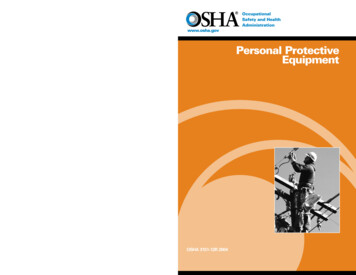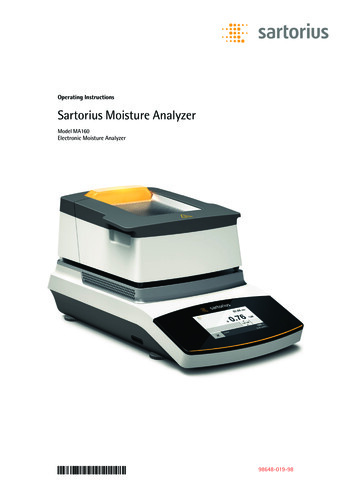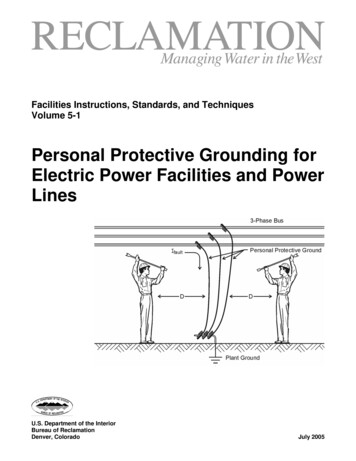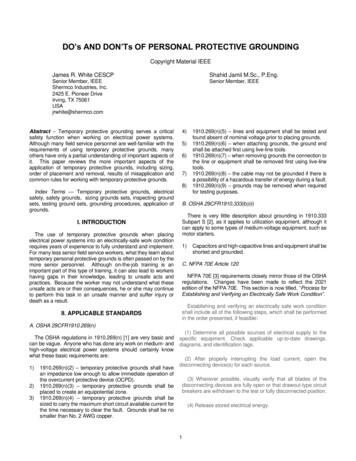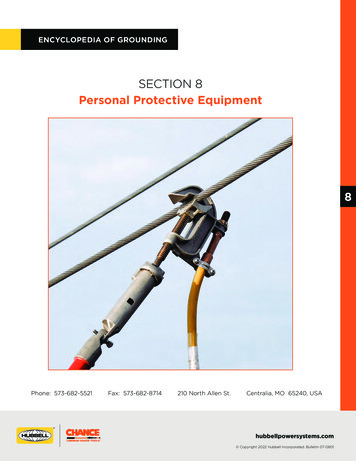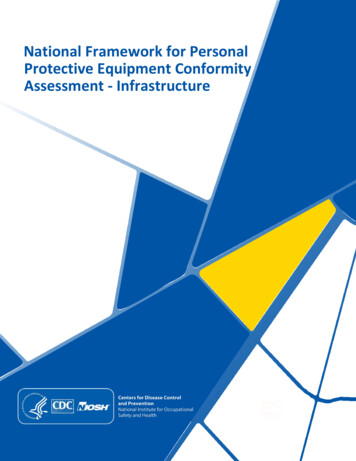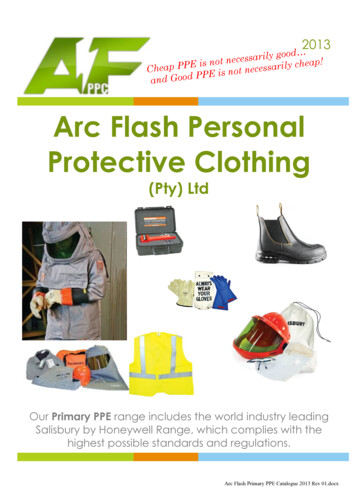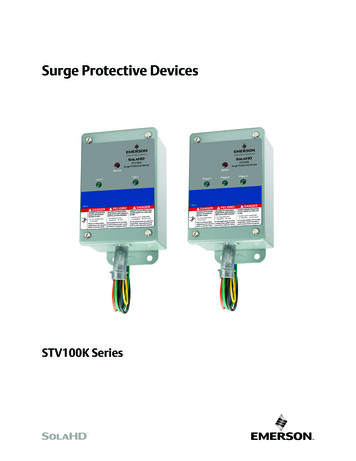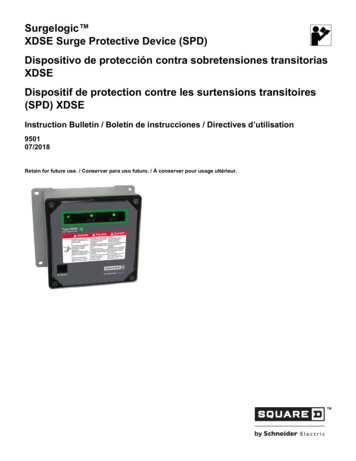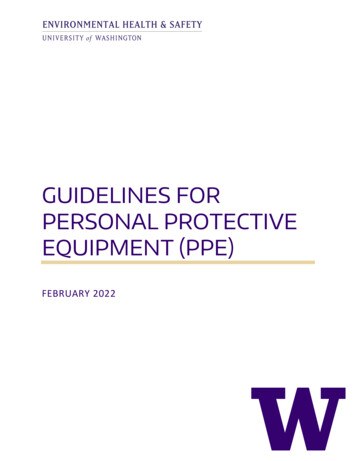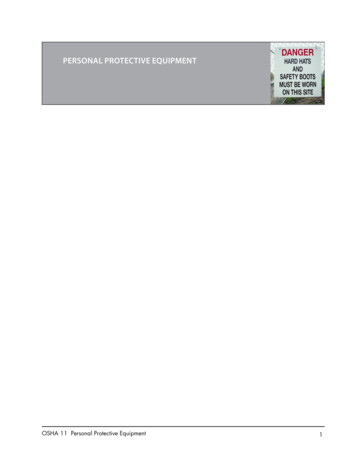
Transcription
Personal Protective EquipmentOSHA 11 Personal Protective Equipment
OSHA 11 Personal Protective Equipment
Personal Protective EquipmentLearning ObjectivesBy the end of this lesson, students will be able to: List types of Personal Protective Equipment (PPE) that can be used to protect the hands,face, head, eyes, and feet. Describe the hazards each type of PPE protects against. Explain why workers may not want to use PPE. Explain what should be included in PPE training, including key criteria to ensure theequipment will be protective: fit, size, appropriate material. Describe/demonstrate the proper way to don gloves, eye protection and/or a hard hat.Time Needed: 40 MinutesMaterials Needed Handouts:What is Personal Protective Equipment? (A)Use the Right Respirator (B)Hand Protection (Gloves) (C)Hearing Protection (D) A bag or box of PPE (as many as possible: hard hat, face mask, goggles, dust masks, andrespirators with filter cartridges, several types of gloves, hearing protection, Tyvek suit.)Preparing to Teach This LessonBefore you present this lesson:1. Make copies of the four different handouts for students.2. Pull together your collection of PPE. You may want to contact a local safety supply vendor;they are often willing to donate some basic PPE.Detailed Instructor’s NotesA. Introduction: Why this subject is important (5 minutes)1. Discuss why this topic is important. PPE can protect workers only if it is properly selected, worn, and maintained. That’s whytraining is important. Each year over 100,000 people have temporary or permanent vision loss because of eyeinjuries. PPE is not just a workplace issue. It’s important in personal life for sports, hobbies, andrecreational activities.OSHA 11 Personal Protective Equipment
B. Handout and Discussion (10 minutes)1. Distribute the Handouts (A), What is Personal Protective Equipment?, (B) Use the RightRespirator, (C) Hand Protection (Gloves), and (D) Hearing Protection. After giving students a fewminutes to review them, hold a class discussion using the following questions:What are some examples of PPE?What are some common jobs where teens are employed?Give some examples of PPE they might need to do their job.Personal protective equipment, or PPE, is designed to protect you from hazards found on or offthe job. Face shields used in ice hockey and helmets used for biking are examples of PPE; otherexamples include goggles, safety glasses, foot protection, coveralls, gloves, vests, earplugs, andrespirators.Why is a PPE considered the least effective type of protection against injury? It may not fully protect you It may be uncomfortable to wear. It requires the employee to have it, put it on, and keep it on. It might not fit correctly.It is important to remember that PPE comes in various sizes. If the PPE does not fit correctly,it may be necessary to find and try a different size or brand. In order for it to be effective andprovide protection, PPE must fit properly.PPE is often used in combination with other hazard-control methods like removing the hazardfrom the workplace and using good work rules.Even though PPE is considered to be the least effective form of protection, there are someconditions where it is the only protection available to protect the worker. For example, ifa worker has to do work in a confined space, they may have to wear a respirator becauseventilation may not be adequate.If PPE is needed, what training is required for its use? How to use PPE the right way When PPE is needed What kind of PPE to use What PPE can and cannot do to protect workers How to put it on, adjust, wear, and take off PPE How to take care of PPEDiscuss additional key points from Handout (B) Use the Right Respirator, (C) Hand Protection(Gloves), and (D) Hearing Protection, during the PPE Grab Bag activity.OSHA 11 Personal Protective Equipment
C. PPE Grab Bag (15 minutes)(or select an alternative activity described in E)1. Put a variety of PPE into a bag or box. Explain that you will be handing out PPE and each person/group should address the following questions about their item and add information as needed.Write these questions on the board.How does this protect you?What training would you need to use this item?What kind of jobs might require wearing such an item?Why might you not want to wear this while working?2. Have each student (or a small group of students) pull an item from the bag.3. Go around the room to as many students or groups as you can and ask them to answer thequestions about their item for the class. If appropriate, ask the student to demonstrate use of theequipment. Hard hats can protect workers’ heads from being hit by objects or coming in contact withelectricity. Different types of hard hats protect against different hazards. Look for themarking ANSI Z89.1. Safety shoes, leggings, and foot guards help protect workers from falling objects, sharpobjects, wet and slippery surfaces, hot surfaces, and electrical hazards. Face shields, goggles, and safety glasses with side shields can protect workers from liquidsand solids that can get into their eyes. Look for the marking ANSI Z87.1. Earplugs or earmuffs can help prevent damage to hearing. Exposure to high noise levelscan cause irreversible hearing loss as well as physical and psychological stress. Gloves can protect workers’ hands from chemicals, hot and cold temperatures, vibrationand sharp objects. Gloves must fit properly and be the right kind of material for the job.Instructors Note: It is important to be aware that different types of glove materialswill protect against different types of chemicals. For example a nitrile glove willprovide better protection against solvents than a latex glove will. (a glove materialpermeation chart can be viewed at: ChemicalResistanceGuide.pdf ) Respirators. Employers must first try to remove breathing hazards. If they can’t, workersmay have to wear respirators. The kind of respirator required depends on the kind ofhazard the worker is exposed to. For example, dust masks do not protect against chemicalvapors. (See Handout (B) Use the Right Respirator.) Respirators must also fit correctlyin order to prevent illness. If a worker has to wear a respirator, it is the employersresponsibility to provide the employee with a medical evaluation to make sure they arehealthy enough to work safely in a respirator. Full body suits. In some cases workers must protect most or all of their bodies against heat,cold, radiation, hot metals and liquids, body fluids, or hazardous materials.OSHA 11 Personal Protective Equipment
D. Additional ResourcesOSHA’s webpage on personal protective wnload/Ansell 7thEditionChemicalResistanceGuide.pdfE. Alternative ActivitiesThe following short descriptions of activities are provided as an alternative to the PPE Grab Bag Activity.PPE Grab Bag for Specific Trade: Same concept as the PPE Grab Bag, but you focus on the trade youare teaching and have PPE commonly used for the trade (e.g. construction, welding, etc.).PPE Zones: Display or hand out a drawing of a body divided into five zones (head, torso, legs, hands,and feet). Have students think about what job hazards, for specific occupations, might be relevant foreach body zone and what PPE might be appropriate for protecting that zone. You could draw bodiesfor different occupations and divide the class into small groups to do the activity, concluding witheach group sharing their picture with the class.PPE Shopping: PPlace PPE samples on a table and give each student or group of students a job(construction, restaurant worker, etc.). Ask students to consider the hazards they may face, then havethem shop for the PPE on the table. You may have prices associated with each piece of PPE; askstudents to track how much they might have to spend for PPE.Incorporate PPE with skills, tools, and jobs you are already teaching. Take the opportunity toelaborate on the proper use of PPE as you teach your other skill sets.The following OSHA and State of Washington L&I-DOSH-WISHA codes correspondto information in this unit:OSHA 29 CFR 1910.134L & I DOSH WISHA WAC 296-800-160 Personal Protective Equipment (PPE)OSHA 11 Personal Protective Equipment
Handout AWhat is Personal Protective Equipment?Personal protective equipment, or PPE, is designed to protect you fromhazards found on or off the job. Face shields used in ice hockey and helmetsused for biking are PPE; other examples include goggles, safety glasses, footprotection, coveralls, gloves, vests, earplugs, and respirators. If you mustwear PPE for your job, your employer must train you to use it properly.Some PPE must comply with national standards, called ANSI standards.For example on safety glasses look for the ANSI marking “Z 87” on thetemples of the glasses.When do you need PPE?Employers must assess their workplaces to find out if there are hazards thatrequire workers to use PPE. If there are such hazards, employers must selectthe right type of PPE and make sure it fits the employee correctly. In mostcases, the employer isrequired to supply PPE to their workers at no charge, however there may be exceptions if you wearyour PPE off the job site. Employers must train workers who have to use PPE on how to use it correctly.This includes the following: Knowing when PPE is needed How to use PPE correctly Knowing what kind of PPE to use Understanding what PPE can and cannot do to protect workers How to put on, adjust, wear, and take off PPE How to maintain PPE.LimitationsPPE is the least effective way to protect you from hazards. That’s because it may not fully protect youand may be uncomfortable to wear. However, you still have to wear it if your job requires it. PPE isoften used in combination with other ways to control hazards, like removing the hazard or usinggood work rules. Even though PPE is the least effective form of protection, there are some conditionswhere it is the only protection that may be available to the worker.Can PPE protect workers from head injuries?Yes. Hard hats can protect workers’ heads from being hit by objects or coming in contact withelectricity. Different types of hard hats protect against different hazards. Look for the markingANSI Z89.1.How can PPE protect workers from foot and leg injuries?Safety shoes, leggings, and foot guards help protect workers from falling objects, sharp objects, wetand slippery surfaces, hot surfaces, and electrical hazards.OSHA 11 Personal Protective Equipment
Does PPE help protect workers from eye and face injuries?Yes. Face shields, goggles, and safety glasses with side shields can protect workers from liquids andsolids that can get into their eyes. Look for the marking ANSI Z87.1.What can PPE do to protect workers from hearing loss?Wearing earplugs or earmuffs can help prevent damage to hearing. Exposure to high noiselevels can cause irreversible hearing loss as well as physical and psychological stress.Should workers wear PPE to help prevent hand injuries?Yes. Gloves can protect workers’ hands from chemicals, hot and cold temperatures, vibration and sharpobjects. Gloves must fit properly and be the right kind for the job.Why should workers wear PPE to protect the whole body?In some cases workers must protect most or all of their bodies against heat, cold, radiation, hot metalsand liquids, body fluids, or hazardous materials.When should workers wear PPE for respiratory protection?Employers must first try to remove breathing hazards. If they can’t, workers mayhave to wear respirators. The kind of respirator you need depends on what kind ofhazard you are exposed to. For example, dust masks do not protect you from chemical vapors. Respirators must fit correctly in order to help prevent illness. All workersrequired to wear respirators must first have a medical evaluation paid for by the employer.REMEMBER: PPE is the last line of defense against workplace hazards.Even though PPE is considered to be the least effective form of protection, there are some conditionswhere it is the only protection that may be available to the worker.OSHA 11 Personal Protective Equipment
Handout BIf you do have to wear a respirator, it is important tonote that a medical evaluation is required. OSHA 11 Personal Protective Equipment
OSHA 11 Personal Protective Equipment10
Handout CHand Protection (Gloves)Don’t take your hands for granted. Can you imagine trying to work without your hands?Hand injuries include cuts, burns, fractures, amputations, nerve damage and skin rashes.Skin irritation, rashes, and even poisoning can occur from handling chemicals with bare hands.Gloves can protect hands from: Knives, sharp edges, splintersChemicalsBlood and bodily fluidsExcessive vibrationHot objectsElectricity Extreme coldThere are many types of protective gloves: Leather gloves protect your hands from rough surfacesSpecial insulated gloves can protect your hands from hot objectsCut-resistant gloves prevent or reduce cuts from knives or sharp edgesAnti-vibration gloves reduce the effects of vibration from hand tools and machineryDisposable gloves protect against blood and germsElectrically insulated gloves are used to handle live wires or energized electrical equipmentDifferent glove materials will protect against different types ofchemicals; make sure you have the right kind of glove for thechemical you are using.(To view a sample glove permeation chart, go tohttp://www.ansellpro.com/download/Ansell 7thEditionChemicalResistanceGuide.pdf )Gloves do have limitations: Gloves can get caught on rotating machineryLatex gloves can cause severe allergic reactions in people allergic to latex.Gloves can cause problems if chemicals get inside the glovesGloves can fail in conditions of extreme temperatures, high mechanical force, high vibrationor extremely harsh chemicals If you have the wrong kind of glove, it may not protect you. For example, certain kinds ofchemical solvents can go right through standard rubber or latex gloves.OSHA 11 Personal Protective Equipment11
Glove use and care: Use the correct size and fit of glove to give you the needed dexterity Clean your hands before using gloves Clean fabric and leather gloves regularly or discard them Do not use latex gloves if you are sensitive to latex or have a latex allergy Replace gloves if they have cuts, tears, holes or defects Make sure gloves are right for the job—don’t use leather or fabric gloves to handle liquidchemicals.OSHA 11 Personal Protective Equipment12
Hearing ProtectionHandout DExposure to loud noise will inevitably cause hearing loss over time. Protectyour hearing! A good rule of thumb: if you have to shout to be heard, thenoise level is damaging your hearing.There are two types of hearing protection: earplugs and ear muffs. All hearingprotectors are designed to reduce the intensity (loudness) of noise for theinner ear.EarplugsEarplugs are made of foam, rubber, or plastic. They can be one size fits allor small, medium, or large. Many earplugs are disposable, but some arereusable. They are lightweight and require no maintenance. They are insertedinto the ear canal. At first, some people may find earplugs uncomfortable to wear for long periods oftime, but most people can find a comfortable fit by trying different sizes or brands. There are evencustom-molded earplugs.Ear MuffsEar muffs cover the whole ear. They have replaceable pads and some types can filter out specific noisepitches. Ear muffs last longer than most earplugs, but they can be uncomfortable in hot weather andmay not fit well over glasses or people with heavy sideburns.Noise reduction rating:The “noise reduction rating” or “NRR” of hearing protection is measured in decibels.The NRR is found on the ear muff or earplug package. The higher the number, the greaterthe protectionProper Use of Hearing Protection: Hearing protection only works when used properly. You cannot remove hearing protection for just a minute in a noisy area. It takes just a few minutes of unprotected exposure at noise above 115 decibels to risk hearingdamage. Earplugs not inserted properly into the ear canal will not provide complete protection. Ear muffs not snug against the head will leak noise into the ear. Portable music devices do not provide protection against noise—they only add to it.This material was adapted from Washington State Department of Labor and Industries training tools:Noise Exposure at WorkOSHA 11 Personal Protective Equipment13
OSHA 11 Personal Protective Equipment14
List types of Personal Protective Equipment (PPE) that can be used to protect the hands, face, head, eyes, and feet. Describe the hazards each type of PPE protects against. Explain why workers may not want to use PPE. Explain what should be included in PPE

